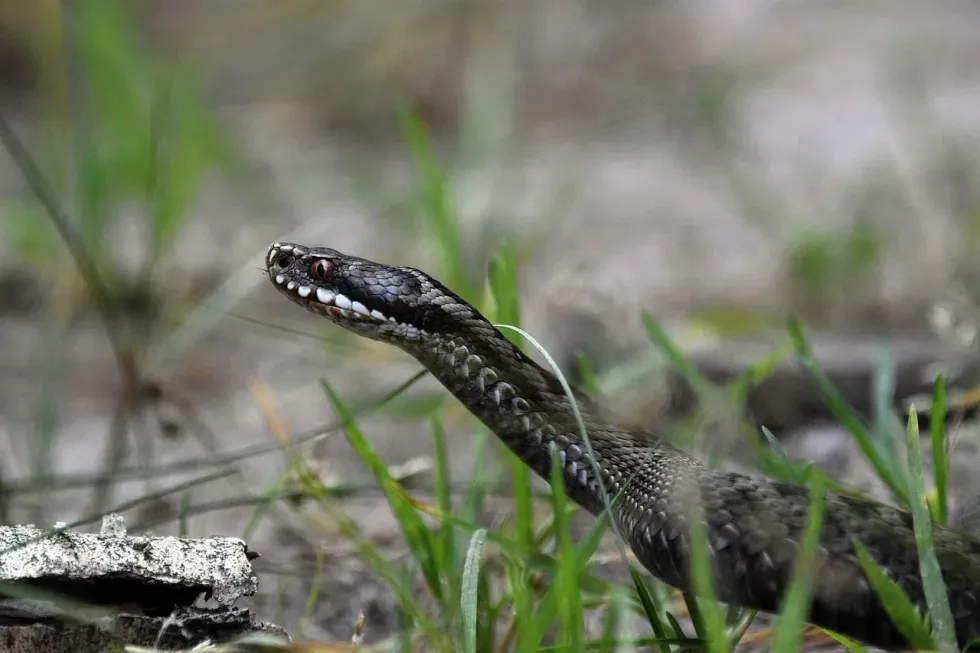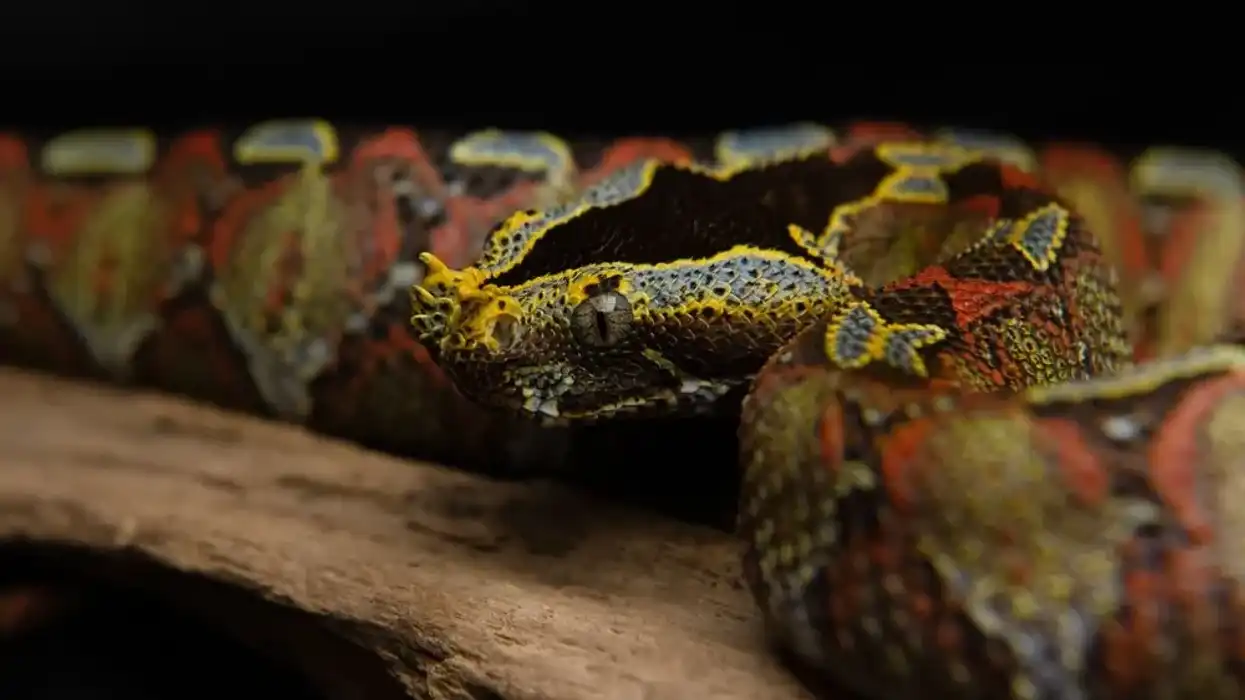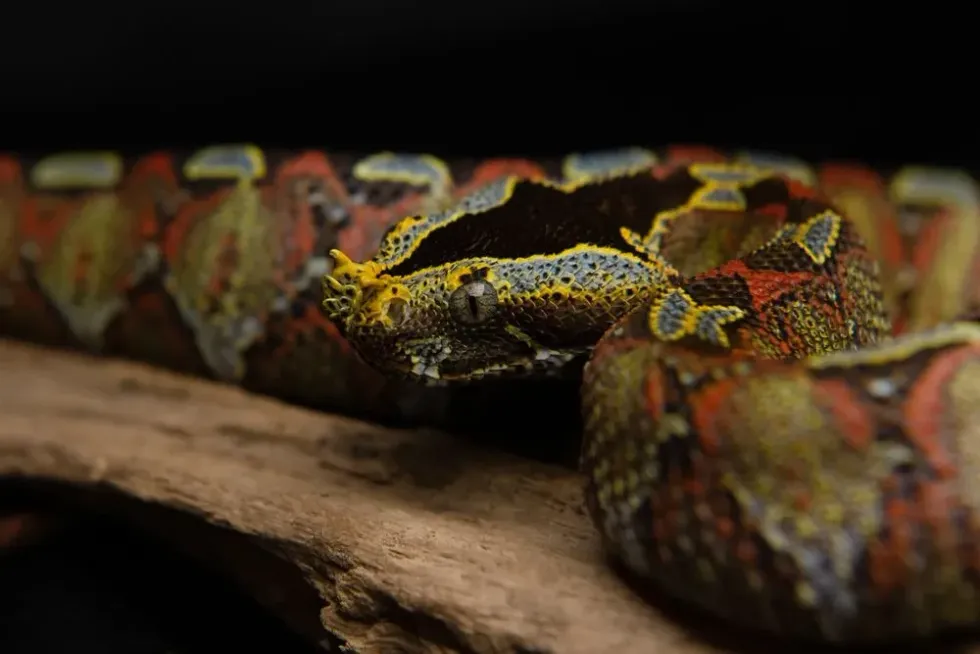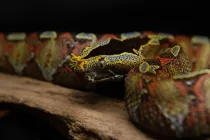Fun Rhinoceros Viper Facts For Kids
Bitis nasicornis snakes are known by the common name: rhinoceros viper. They are called so because of the scales that produce horns on its head.
The Bitis nasicornis is also popularly known by other names too, such as the river jack, the butterfly viper, the horned puff adder, and the rhinoceros horned viper. It is a large viper snake and is the only recorded subspecies of the family Viperidae.
The Bitis nasicornis (or the rhino viper) is a native snake of the vast African tropical forest habitat and is found mainly in central and western parts of the continent. They inhabit humid and swampy African forests and on some occasions venture into woodlands or savannas.
They are one of the most dangerous poisonous snakes in the world and even a small amount of their venom is deadly.
Even the young snakes are dangerously venomous and yet they show beautiful coloration. Although they exhibit a sluggish movement normally, during hunting they have an impressive speed.
They commonly hunt by the method of ambush. To know more about this species of snakes continue reading these amazing rhinoceros viper facts.
For similar content check out our facts about the vine snake and mangrove snake too.
Rhinoceros Viper Interesting Facts
What type of animal is a rhinoceros viper?
Bitis nasicornis, commonly referred to as the rhinoceros viper, is a type of large venomous snake.
What class of animal does a rhinoceros viper belong to?
The rhinoceros viper belongs to the class Reptilia, which is the common class for all reptiles.
How many rhinoceros vipers are there in the world?
The population pattern of the Bitis nasicornis is hard to determine, as they are difficult to locate in forests because of their cryptic color combination. However, it is assumed that they are abundant in their locality, and in one survey, around 282 rhino vipers were located within a few kilometers.
Where does a rhinoceros viper live?
The geographic range of the viper Bitis nasicornis includes parts of different African tropical forests. The rhinoceros viper distribution ranges from Guinea to Togo in Africa and they can be found at the highest elevation of 4987 ft (1520 m).
Some species have been also located as far south as in the southern tip of Zaire. These snakes are distributed in the interior parts of the forest.
In central Africa, their distribution ranges from Guinea to Liberia.
They cover territories extending from Ghana to Kenya. Some other common countries where these snakes are found are southern Sudan, Gabon, Cameroon, Uganda, the Ivory Coast, Angola, Zambia, Nigeria, Tanzania, Nigeria, the Central African Republic, and in central, eastern, and western parts of the Democratic Republic of the Congo.
What is a rhinoceros viper's habitat?
The typical rhinoceros viper habitat is a more restricted one than the habitat of other vipers. Their preference for the humid-prone lands of Africa has made them a common snake in wet and damp forests and even in moist agro-industrial plantations in the continent.
These terrestrial snakes can, at times, be seen climbing or resting on trees. Other habitats include different aquatic environments and water bodies like sluggish streams or swampy lakes.
As a result of this preference, the rhino viper is also referred to as the river jack.
They are found in the lowland regions of deep rainforests, where regular floods have made the soil damp and moist. Since they have adapted well in the interior parts of thick and dry forest territories or wet forest pools, their presence is not felt at all in towns.
Who do rhinoceros vipers live with?
Being solitary animals, rhinoceros vipers generally lay on the forest's floor all by themselves.
How long does a rhinoceros viper live?
The rhinoceros horned viper can live longer in captivity as compared to in the wild. In the wild, they live for eight years. However, in captivity, they can live a life of at least 13 years.
How do they reproduce?
The rhinoceros horned viper is a viviparous snake species, so the young snake is born after internal development within the female snake, who gives birth to live young. The breeding season of these snakes lasts for a short while between April and May.
They mate by twisting tails with their partners. Bitis nasicornis snakes give birth to multiple offspring, mainly at the start of the rainy season between March and April in West Africa.
In the eastern parts, they do not have a definite breeding season. The litter size normally ranges between six and 35 babies and all of them are around 7–10 in (18–25 cm) long.
The babies are left by the parents to fend for themselves. Although the rhino viper is a highly venomous snake, many of them are bred in captivity.
What is their conservation status?
Scientists do not show any concern yet regarding the population of the rhinoceros viper species. The IUCN Red List has identified them as a species of Least Concern.
They are present in abundance in their habitats and along with that, they are also present in large numbers in protected areas. Their population certainly faces some threats, among which deforestation and forest degradation are some of the main ones. However, there is no significant effect on their range as of yet.
Rhinoceros Viper Fun Facts
What do rhinoceros vipers look like?
The rhino viper or the Bitis nasicornis has a massive and stout body with very strong and keeled scales. These snakes have a particular and distinguishable small head which is connected with their body by their thin neck and they have a large triangular mark on their head.
Their horns are located at the front, on the nose, and on the side behind the ears. Although they are one of the most venomous snakes in the world, they do not possess large fangs.
Their eyes are small and far apart from each other. Their dorsal end consists of 31-43 rows of sharp scales that can produce deep cuts if these snakes are not handled properly.
Their ventral scales are more abundant in number in this largely built snake, ranging from 117-140.
However, only one anal scale is present at the end of the rhino viper's body. Their body is covered with a beautiful velvety skin of triangular, diamond-shaped, or rectangular patterned scales, quite similar to gaboon vipers, but much brighter than the latter.
Their skin shows a large variety of coloration which include colors like black, yellow, green, blue, gray, and white. The rhino viper loses its bright coloration after it sheds its skin.
The cryptic coloration acts as a remarkable adaptation in its environment, which helps these snakes to hide within leaves or the forest floor and to strike on their prey easily.

* Please note this is an image of a viper snake, not a rhinoceros viper. If you have an image of a rhinoceros viper, please let us know at hello@kidadl.com/
How cute are they?
They are not generally considered cute, but their beautiful skin acts as an attraction to many and hence they are often kept in zoos.
How do they communicate?
Like all snakes, rhino vipers mainly communicate by hissing. When angry, a loud rhinoceros viper hiss is produced from their respiratory organs. Otherwise, they generally remain quiet. The snake also has a keen sense of smell for tracking its prey.
How big is a rhinoceros viper?
The Bitis nasicornis is a large and stout snake, whose total body length including the tail ranges between 28-42 in (71-107 cm). The largest verified rhinoceros viper had a total length of 47 in (119 cm). Females are generally larger than males and the rhinoceros viper is a few inches smaller than the South American gaboon viper.
How fast can a rhinoceros viper move?
The rhinoceros viper is a slow-moving sluggish snake and cannot move fast owing to its large build. Despite that, they can strike strongly and quickly both sideways and in a forward direction. They spend their life mostly motionless and are most active at night.
How much does a rhinoceros viper weigh?
The Bitis nasicornis, or the rhinoceros viper, is a species of large and thick snakes and they can weigh up to 22 lb (10 kg).
What are their male and female names of the species?
Male and female snakes do not have any particular names for this animal. Both of them are called rhinoceros viper snakes.
What would you call a baby rhinoceros viper?
The babies of snakes are called different things at different stages. A newly born offspring is known as a neonate, while the juvenile animal is called a nestling.
What do they eat?
The diet of Bitis nasicornis snakes includes any small animal that is available in its wetland area. They wait for their prey and generally strike only when the prey comes into their vicinity.
Their most common foods include small mammals, toads, fish, and frogs. Rhinocerous viper snake bites inject a small amount of highly poisonous hemotoxic venom into their prey, destroying the circulatory system and causing internal bleeding.
Are they aggressive?
The rhinoceros horned viper is generally not that aggressive and does not tend to attack much. Moreover, they stay away from human settlements, so attacking humans is very rare.
However, they are one of the most venomous snakes, making their bites very dangerous. The rhinoceros viper's venom is hemotoxic in nature and even a small amount of venom would kill human beings. It is a very deadly animal.
Would they make a good pet?
It is unusual as well as dangerous to have a pet Bitis nasicornis. Their bites contain small doses of hemotoxic venom, which can be deadly.
A small amount of rhinoceros viper venom can cause internal hemorrhage, tissue decay, and circulatory failure. Their scales are also very sharp and can cause deep cuts if the snake is not handled carefully. However, the Bitis nasicornis is found in some zoos, where they are trained only by professionals.
Did you know...
They have fangs that remain folded on the roof of the rhinoceros viper's mouth. Also, six replacement pairs of fangs are present.
What color are viper snakes?
The Bitis nasicornis is one of the most beautiful snakes among all snakes of the world, as it shows a large range of body colors. These colors are also an adaptive feature of the snake, that lets them camouflage in their natural habitat and attack their prey more successfully.
Some blue or bluish-green blocked markings are present on the upper part of the body and the markings have a lemon yellow detailing running through the center of each block.
The blocks are enclosed by irregular-shaped black structures. A crimson-colored triangular pattern runs down on each side of the flanks and this series of triangles are narrowly edged by a green or blue color.
The end of the lateral scales are detailed with small white spots and that sometimes give off a velvet-like appearance of the snake's skin. The under part of the snake is not as colorful as the upper part.
The belly has dirty white or dull green scales and contains marbled patterns of a black and gray color. The head of the rhinoceros viper snake is either blue or green in color, with a black arrow as its identifying character.
Snakes of different areas show different coloration.
For example, snakes of this species in western Africa look bluer in color than eastern ones. The coats of east African snakes of this species are slightly more on the greener side.
What does the rhinoceros viper do when threatened or excited?
The rhinoceros horned viper is considered to be one of three puff adders that are currently present in the world. A general characteristic of all puff adders is that when excited, the snakes puff themselves up, which makes them look larger than their original size.
Similarly, when the Bitis nasicornis feels threatened or become excited, they inflate their bodies to create a puffed look. This reptile can also make a hissing noise from their nose as a part of their respiratory function.
Here at Kidadl, we have carefully created lots of interesting family-friendly animal facts for everyone to discover! Learn more about some other reptiles from our cottonmouth snake and copperhead snake facts pages.
You can even occupy yourself at home by coloring in one of our free printable rhinoceros viper coloring pages.
We Want Your Photos!
More for You
Bachelor of Arts specializing in Journalism and Mass Communication, Postgraduate Diploma in Sports Management

Moumita DuttaBachelor of Arts specializing in Journalism and Mass Communication, Postgraduate Diploma in Sports Management
A content writer and editor with a passion for sports, Moumita has honed her skills in producing compelling match reports and stories about sporting heroes. She holds a degree in Journalism and Mass Communication from the Indian Institute of Social Welfare and Business Management, Calcutta University, alongside a postgraduate diploma in Sports Management.
Disclaimer
1) Kidadl is independent and to make our service free to you the reader we are supported by advertising. We hope you love our recommendations for products and services! What we suggest is selected independently by the Kidadl team. If you purchase using the Buy Now button we may earn a small commission. This does not influence our choices. Prices are correct and items are available at the time the article was published but we cannot guarantee that on the time of reading. Please note that Kidadl is a participant in the Amazon Services LLC Associates Program, an affiliate advertising program designed to provide a means for sites to earn advertising fees by advertising and linking to Amazon. We also link to other websites, but are not responsible for their content.
2) At Kidadl, we strive to recommend the very best activities and events. We will always aim to give you accurate information at the date of publication - however, information does change, so it’s important you do your own research, double-check and make the decision that is right for your family. We recognise that not all activities and ideas are appropriate for all children and families or in all circumstances. Our recommended activities are based on age but these are a guide. We recommend that these ideas are used as inspiration, that ideas are undertaken with appropriate adult supervision, and that each adult uses their own discretion and knowledge of their children to consider the safety and suitability. Kidadl cannot accept liability for the execution of these ideas, and parental supervision is advised at all times, as safety is paramount. Anyone using the information provided by Kidadl does so at their own risk and we can not accept liability if things go wrong.
3) Because we are an educational resource, we have quotes and facts about a range of historical and modern figures. We do not endorse the actions of or rhetoric of all the people included in these collections, but we think they are important for growing minds to learn about under the guidance of parents or guardians.







